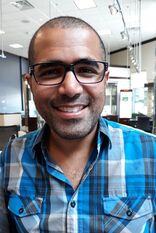Insider Brief
- Researchers at Howard University’s Quantum Biology Lab “use techniques from quantum optics, quantum information, theoretical physics, spectroscopy, structural/molecular biology and high-performance computing to solve an array of problems relevant to quantum effects in living processes.”
- Physicist Philip Kurian, founder of the Quantum Biology Lab at Howard University, leads interdisciplinary research exploring how quantum effects may operate in biological systems and influence both medicine and future machine design.
- Among the lab’s successes, the team has found experimental evidence that biological systems may naturally exhibit quantum effects, which could inform the design of future quantum machines.
- Image: Science Advances
Biological systems may already be solving problems that challenge the world’s most advanced quantum computers.
That’s the claim emerging from a decade of work at Howard University’s Quantum Biology Lab, where physicist Philip Kurian and his team are tracking how living matter acts at the quantum level — and whether those interactions offer clues for medical treatments, as well as insights into building new types of machines.
Quantum Biology Lab
Kurian founded the Quantum Biology Lab at Howard University in 2015 with the goal of bridging physics and biology.
Over the last ten years, the group has progressed from theoretical calculations to experimental validation, including recent findings that support a once-dismissed idea: that biological materials can exhibit non-trivial quantum effects even at room temperature. One key result centers on a phenomenon known as “single-photon superradiance”, which is a quantum phenomenon where a group of molecules emits light together in a synchronized way, producing a stronger and faster burst of energy than they would individually. Typically studied under ultra-cold conditions, Kurian’s lab has shown signs of this effect occurring in protein fibers under thermal equilibrium biological conditions.

Principal Investigator and Founding Director
“So, what makes the discovery so compelling is that it shows that there is something non-trivial about the way biological systems organize themselves in a hierarchical, symmetrical fashion that make their ability to interact with the electromagnetic field much more strong and robust than what would be possible at the single-molecule level,” said Kurian.
Kurian argues this changes the conversation about what biology can do.
Rather than treating biological systems at the level of single proteins, which are frequently too noisy or disordered for quantum effects to survive, his work suggests that certain symmetries found in longer protein filaments and bundled aggregates might actually protect and sustain these effects. While first experimental evidence was published in The Journal of Physical Chemistry in 2024 with colleagues in Italy and Switzerland, additional confirmations from experiments planned this summer could mean that quantum behavior is not just incidental in life’s processes, but fundamental to how those processes work.
The experimental validation published last year was achieved through a simple but technically demanding observable—called the fluorescence quantum yield—that can be measured using standard spectrophotometric tools available in many molecular biology labs. This approach, he stresses, makes the results more accessible and less dependent on exotic experimental infrastructure.
Quantum Biology and Beyond
These ideas and their implications aren’t restrained just to biology. The impact on fields such as computing may stretch far beyond our current expectations.
For example, Kurian’s team is collaborating with researchers in Japan and at Tufts University to develop a bio-computer based on a unicellular, aneural slime mold. The organism, Physarum polycephalum, has already shown the ability to solve certain optimization problems, such as the traveling salesman problem, with surprising efficiency. While the current research focuses on macroscopic oscillations, Kurian believes the mold may eventually be shown to use quantum behaviors to arrive at its solutions. The organism’s ability to evaluate tens of thousands of paths in near-linear time with increasing problem size raises questions about whether biology is making use of quantum algorithms under the wetware hood.
Kurian said, “Now there are many nuances to this, but it is one really intriguing line of research that begs the question, could an organism be exploiting quantum degrees of freedom for an actual behavioral or problem-solving task?”
This may serve to catalyze a broader shift in how scientists and engineers approach machine design, according to Kurian. Instead of treating biology as only something to be imitated through classical reverse engineering, he believes living systems may hold the key to future quantum architectures. Collective behaviors in molecular qubit systems, such as those found in protein bundles, could inspire new quantum devices that are more robust to noise than current hardware.
“We are trying to understand whether nature has already figured out how to solve some of the problems we’re struggling with in quantum technology,” Kurian says. “Life is doing something very distinct from supercooled, isolated quantum devices, and it’s found a way to maintain a quantum signal above the thermal noise floor.”
Towards Practical Quantum Biology
The lab’s research also has implications in medicine, especially in the area of neurodegeneration.
In a 2024 follow-up study published in Frontiers in Physics, Kurian’s team examined amyloid fibrils – structures commonly associated with Alzheimer’s disease and other dementias – and suggested they might serve a neuroprotective function. The paper predicts that these fibrils exhibit superradiance, potentially shielding neurons from damaging ultraviolet photons generated by oxidative stress. Kurian contends that these aggregates, which most see as pathological, might actually be the brain’s attempt to mitigate internal photodamage in the early stages of cognitive decline.
This view, of course, would be seen as a challenge to the dominant amyloid cascade hypothesis, calling for a serious re-evaluation of decades of anti-amyloid drug development efforts. Still, the director of the USC California Alzheimer’s Disease Center, who was not involved in the research, praised Kurian’s work.
Kurian added that the findings may help explain why some anti-amyloid therapies – disappointingly – have yet to live up to their promised efficacy. If the fibrils are part of the brain’s internal defense mechanism, targeting them for removal could inadvertently worsen the condition, at least in the early stages of disease. The lab’s computational and spectroscopic work provides a physical mechanism for this neuroprotective role, linking quantum optical effects with previously misunderstood protein aggregation.
Still Room for Acceptance
Quantum biology has come a long way. In the past, some scientists were highly dubious, if not vocally critical, about quantum biology. Despite the promise of the current findings, and a growing community of researchers, quantum biology continues to face skepticism outside the trenches. Kurian attributes this in part to the staunch disciplinary boundaries in science. Physicists may view biology as too messy and complicated for systematic analysis, while biologists may see quantum mechanics as too far from the scales and behaviors they are accustomed to.
Some of these barriers might be ones of communication, he added.

“When you’re doing cross- or trans-disciplinary science and you’re trying to gain momentum around some of these discoveries, there is, number one, a communication challenge,” Kurian said. “There are communication gaps everywhere, as wide as the length, time, and energy scales we wish to traverse.”
Kurian’s own background reflects that translational mindset. Trained in graduate school as a theoretical (quantum) physicist, he immersed himself as a postdoc in chemistry, biology, and computational science to build a lab that spans all four disciplines. Today, his team includes specialists in computational biology, quantum optics, and molecular spectroscopy. Their tools range from the theory of open quantum systems, to numerical simulations and fluorescence and vibrational spectroscopies designed to detect how quantum behavior survives and even thrives under biological conditions.
The Future
Quantum biology points toward a future that is increasingly interdisciplinary and one where new technologies will converge, according to Kurian.
Bolting together a physicist, a biologist, and a data scientist will not necessarily lead to innovation, said Kurian. Scientific teams must be immersed in multiple ways of thinking.
The Quantum Biology Lab is currently using that philosophy to co-lead a proposal for a National Science Foundation Science and Technology Center, dubbed CEQuAL, short for “Center for Exploring Quantum Aspects of Life.” If funded, CEQuAL would be headquartered jointly at Howard University and the University of Arizona. The Center, which would be supported by colleagues from UC Santa Barbara, Nanobiosym Research Institute, and Google Quantum AI, would provide dedicated training programs for researchers who are fluent in quantum theory, biological systems, bio-inspired quantum technologies, various spectroscopies, and multiscale computational modeling. Kurian believes such cross-disciplinary training is essential to advance the field.
Until now, such training has been rare. Kurian notes the United States lacks a central hub for developing this new kind of scientist. He hopes CEQuAL can fill that void, creating a pipeline of researchers who can bridge the gap between the physical and life sciences.
Meanwhile, the lab continues to publish in leading high-impact journals including Science Advances, which just in March highlighted Kurian’s latest work, of cosmic significance, entitled “Computational capacity of life in relation to the universe.” After quite a debate at the Editorial Board, one editor posted on X: “After the reviews came in, the conclusion was that, on the great wide spectrum that stretches from bonkers to brilliant, this is closer to brilliant.”
You can learn more about Howard University’s Quantum Biology Lab here.



0 Comments